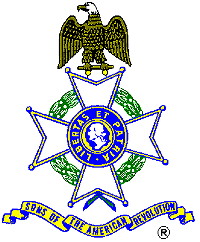

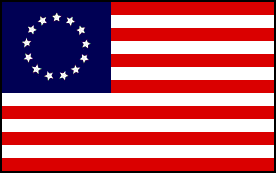 Betsy Ross 1776: The circular
design was credited to George Washington, Robert Morris and
Betsy Ross around 1776. The Congress however did not specify an
arrangement for the stars in the canton, as a result
there are many variations in the flags that followed
until 1912. There is much controversy as to who, what, when
regarding the design and credit of this flag, yet it remains one of the most
popular "versions" to be displayed and remembered as a flag used
in the War for Independence. (THE
FLAG'S LEGEND).
Betsy Ross 1776: The circular
design was credited to George Washington, Robert Morris and
Betsy Ross around 1776. The Congress however did not specify an
arrangement for the stars in the canton, as a result
there are many variations in the flags that followed
until 1912. There is much controversy as to who, what, when
regarding the design and credit of this flag, yet it remains one of the most
popular "versions" to be displayed and remembered as a flag used
in the War for Independence. (THE
FLAG'S LEGEND).
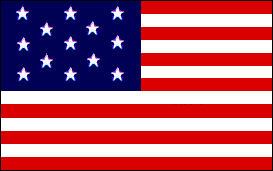 First
Official Flag 1777-1795 Official, also known as First Navy Stars and Stripes:
First
Official Flag 1777-1795 Official, also known as First Navy Stars and Stripes: 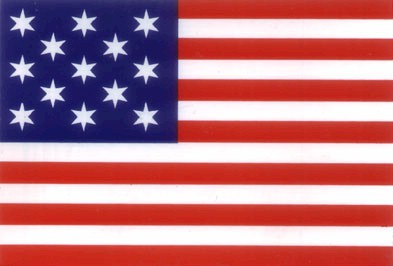 Most
people believe that the Betsy Ross was the first design, but the first
documented U.S.A. flag was the staggered star pattern. This flag was first flown
by Captain John Paul Jones on the USS Ranger. On April 24,1778 John Paul Jones,
in command of the Ranger, became the first American officer to have the American
flag recognized by a foreign power. The original 13 states: CT, DE, GA, MD, MA,
NH, NJ, NY, NC, PA, RI, SC, VA. The design of the
first
Official Stars and Stripes is credited to Francis Hopkinson a popular
patriot, a lawyer, a Congressman from New
Jersey, a signer of the Declaration of
Independence, poet, artist, and distinguished civil servant, had the thirteen
stars arranged in a "staggered" pattern technically known as
quincuncial because it is based on the repetition of a motif of five units. This
arrangement inevitably results in a strongly diagonal effect. In a flag of
thirteen stars, this placement produced the unmistakable outline of the crosses
of St. George and of St. Andrew, as used together on the British flag. There
is no original example of the very first flag still left. Another version is
shown here with a 6 point star design. Researchers continue to debate the exact
appearance of our first national flag so both of these designs are presented
here for your study.
Most
people believe that the Betsy Ross was the first design, but the first
documented U.S.A. flag was the staggered star pattern. This flag was first flown
by Captain John Paul Jones on the USS Ranger. On April 24,1778 John Paul Jones,
in command of the Ranger, became the first American officer to have the American
flag recognized by a foreign power. The original 13 states: CT, DE, GA, MD, MA,
NH, NJ, NY, NC, PA, RI, SC, VA. The design of the
first
Official Stars and Stripes is credited to Francis Hopkinson a popular
patriot, a lawyer, a Congressman from New
Jersey, a signer of the Declaration of
Independence, poet, artist, and distinguished civil servant, had the thirteen
stars arranged in a "staggered" pattern technically known as
quincuncial because it is based on the repetition of a motif of five units. This
arrangement inevitably results in a strongly diagonal effect. In a flag of
thirteen stars, this placement produced the unmistakable outline of the crosses
of St. George and of St. Andrew, as used together on the British flag. There
is no original example of the very first flag still left. Another version is
shown here with a 6 point star design. Researchers continue to debate the exact
appearance of our first national flag so both of these designs are presented
here for your study.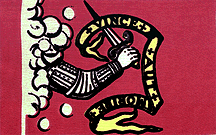 Bedford: This flag was present
at the battle of Concord 19 April 1775. It was carried by
Nathaniel Page, a Bedford Minuteman. The Latin inscription
"Vince Aut Morire" means conquer or die. The arm
emerging from the clouds represents the arm of God. The original
is housed at the Bedford, MA Town Library.
Bedford: This flag was present
at the battle of Concord 19 April 1775. It was carried by
Nathaniel Page, a Bedford Minuteman. The Latin inscription
"Vince Aut Morire" means conquer or die. The arm
emerging from the clouds represents the arm of God. The original
is housed at the Bedford, MA Town Library.
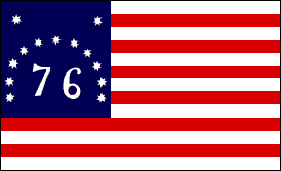 Bennington: This flag flew over
the military stores in Bennington, VT on 16 August 1777. The
American militia led by General John Stark, defeated a large
British raiding force in order to protect military supplies at
Bennington.
Bennington: This flag flew over
the military stores in Bennington, VT on 16 August 1777. The
American militia led by General John Stark, defeated a large
British raiding force in order to protect military supplies at
Bennington.
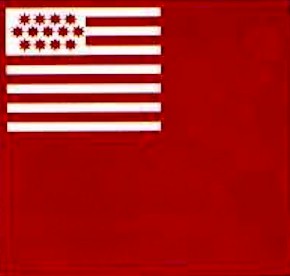 Brandywine
Flag: An early interpretation of the "stars and stripes" is found in the
canton of the still existing red silk division color carried by Captain Robert
Wilson's Company, 7th Pennsylvania Regiment of 1777. The flag is bearing a stars and stripes canton, 7 white stripes
and a white canton bearing 13 red eight-pointed stars in rows of 4-5-4. It is
said to be a militia unit color used at the Battle of Brandywine. According to family
tradition, this flag was carried at Brandywine on September 11, 1777, about
three months after the Continental Congress resolution had defined the flag of
the United States.
Brandywine
Flag: An early interpretation of the "stars and stripes" is found in the
canton of the still existing red silk division color carried by Captain Robert
Wilson's Company, 7th Pennsylvania Regiment of 1777. The flag is bearing a stars and stripes canton, 7 white stripes
and a white canton bearing 13 red eight-pointed stars in rows of 4-5-4. It is
said to be a militia unit color used at the Battle of Brandywine. According to family
tradition, this flag was carried at Brandywine on September 11, 1777, about
three months after the Continental Congress resolution had defined the flag of
the United States.
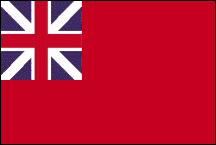 British Red Ensign: This flag is
one of the best known of the British Maritime flags which were
called "Ensigns". This flag is also known as the
British Meteor flag, and was widely used on ships during the
Colonial period. This was considered the first flag used as the
National flag of the United States. The flag was formed by
placing the British Union flag in the canton of another flag
having a field of white, blue or red. So you might see three
variations of this flag.
British Red Ensign: This flag is
one of the best known of the British Maritime flags which were
called "Ensigns". This flag is also known as the
British Meteor flag, and was widely used on ships during the
Colonial period. This was considered the first flag used as the
National flag of the United States. The flag was formed by
placing the British Union flag in the canton of another flag
having a field of white, blue or red. So you might see three
variations of this flag.
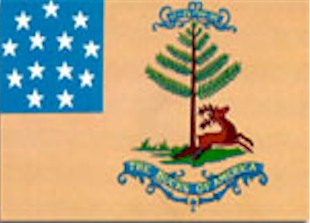 Bucks
of America: A
regiment of volunteer
freemen of color, this was the only document black military
unit of the Revolutionary War. General
George
Washington and Massachusetts Governor John Hancock presented these regimental
colors to the unit. Their initials are part of the design. The original
flag is preserved and on display in Boston at the Massachusetts Historical
Society.
Bucks
of America: A
regiment of volunteer
freemen of color, this was the only document black military
unit of the Revolutionary War. General
George
Washington and Massachusetts Governor John Hancock presented these regimental
colors to the unit. Their initials are part of the design. The original
flag is preserved and on display in Boston at the Massachusetts Historical
Society.
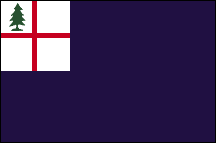 Bunker Hill: On the nights of 16
and 17 June 1775, the Americans fortified Breed's and Bunker
Hills which overlooked Boston Harbor. Although they had not
officially declared their independence, a fight was brewing. The
British advanced up the slope the next day and saw this flag,
possibly a red or blue banner. So one might find two variations
of this flag. Many early Colonial flags had been made by altering
the English flag and most still contained a reference to England.
The Colonists still saw themselves as British subjects but were
declaring their right to be free from violation of their
liberties.
Bunker Hill: On the nights of 16
and 17 June 1775, the Americans fortified Breed's and Bunker
Hills which overlooked Boston Harbor. Although they had not
officially declared their independence, a fight was brewing. The
British advanced up the slope the next day and saw this flag,
possibly a red or blue banner. So one might find two variations
of this flag. Many early Colonial flags had been made by altering
the English flag and most still contained a reference to England.
The Colonists still saw themselves as British subjects but were
declaring their right to be free from violation of their
liberties.
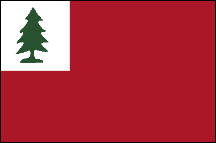 Continental: This flag uses a
version of the British Red Ensign or Meteor flag with a green
pine tree substituted for the British Union flag in the canton.
The Continental flag is believed to have been on of the flags
carried at the Battle of Bunker Hill.
Continental: This flag uses a
version of the British Red Ensign or Meteor flag with a green
pine tree substituted for the British Union flag in the canton.
The Continental flag is believed to have been on of the flags
carried at the Battle of Bunker Hill.
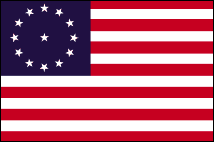 Cowpens: The Cowpens flag was
first carried by the Third Maryland Regiment which was part of
the Continental line of Maryland, Virginia and Georgia regiments.
On 17 January 1781, General Daniel Morgan won a decisive victory
against the British at Cowpens, SC. The original flag is stored
in the state house in Annapolis, MD.
Cowpens: The Cowpens flag was
first carried by the Third Maryland Regiment which was part of
the Continental line of Maryland, Virginia and Georgia regiments.
On 17 January 1781, General Daniel Morgan won a decisive victory
against the British at Cowpens, SC. The original flag is stored
in the state house in Annapolis, MD.
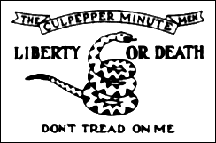 Culpepper Minute Men: This
flag represented a group of minutemen from Culpepper, VA. These
men formed part of Colonel Patrick Henry's First Virginia
Regiment of 1775. In October and November of 1775 three hundred
such minutemen, led by Colonel Stevens, assembled at Culpepper
Court House and marched toward Williamsburg. Their unusual dress
alarmed the people as they marched through the country. The words
"liberty or death" were in large white letters on the
chests of their hunting shirts. They had bucks' tails in their
hats while it is reported that tomahawks and scalping knives were
hung in their belts.
Culpepper Minute Men: This
flag represented a group of minutemen from Culpepper, VA. These
men formed part of Colonel Patrick Henry's First Virginia
Regiment of 1775. In October and November of 1775 three hundred
such minutemen, led by Colonel Stevens, assembled at Culpepper
Court House and marched toward Williamsburg. Their unusual dress
alarmed the people as they marched through the country. The words
"liberty or death" were in large white letters on the
chests of their hunting shirts. They had bucks' tails in their
hats while it is reported that tomahawks and scalping knives were
hung in their belts.
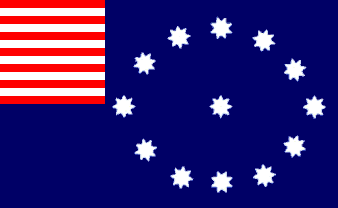 Easton
Flag: The legend attached to this flag is is that it was
displayed on 8 July 1776 for the reading of the Declaration of Independence
in Easton, Pennsylvania. In reality it is in all
likelihood the Company Color of Captain Abraham Horn's Militia Company from Easton
raised during the War of 1812. The original survives at the Easton Public
Library.
Easton
Flag: The legend attached to this flag is is that it was
displayed on 8 July 1776 for the reading of the Declaration of Independence
in Easton, Pennsylvania. In reality it is in all
likelihood the Company Color of Captain Abraham Horn's Militia Company from Easton
raised during the War of 1812. The original survives at the Easton Public
Library.
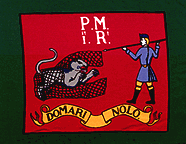 First Continental Regiment-First Pennsylvania
Minutemen Rifle Regiment: The
First Pennsylvania regiment served during the war in each of the
thirteen colonies and it's banner was carried at the battles of
Trenton, Princeton, Brandywine, Monmouth and Yorktown
First Continental Regiment-First Pennsylvania
Minutemen Rifle Regiment: The
First Pennsylvania regiment served during the war in each of the
thirteen colonies and it's banner was carried at the battles of
Trenton, Princeton, Brandywine, Monmouth and Yorktown
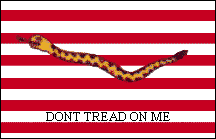 First Naval Jack: This flag is
believed to have flown aboard the Continental Fleet's flagship
Alfred in January, 1776. This flag or one of it's variations was
used by American War ships throughout the Revolution.
First Naval Jack: This flag is
believed to have flown aboard the Continental Fleet's flagship
Alfred in January, 1776. This flag or one of it's variations was
used by American War ships throughout the Revolution.
 Fort Moultrie: This flag was
carried by Colonel William Moultrie's South Carolina Militia on
Sullivan Island in Charleston Harbor 28 June 1776. The British
were defeated that day which saved the south from British
occupation for another two years. Some versions of this flag have
the word "LIBERTY" in the crescent moon. The South
Carolina state flag still contains the crescent moon from this
Revolutionary War flag.
Fort Moultrie: This flag was
carried by Colonel William Moultrie's South Carolina Militia on
Sullivan Island in Charleston Harbor 28 June 1776. The British
were defeated that day which saved the south from British
occupation for another two years. Some versions of this flag have
the word "LIBERTY" in the crescent moon. The South
Carolina state flag still contains the crescent moon from this
Revolutionary War flag.
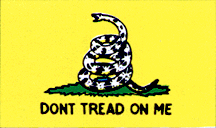 Gadsden: This flag was first
used by Commodore Esek Hopkins who was the first Commander in
Chief of the new Continental Fleet. When his ships put to sea for
the first time in February, 1776, flags with the symbol of the
rattlesnake were flown. the rattlesnake flags were very popular
at time. Colonel Christopher Gadsden of South Carolina copied
this flag and presented it to the Continental Congress.
Gadsden: This flag was first
used by Commodore Esek Hopkins who was the first Commander in
Chief of the new Continental Fleet. When his ships put to sea for
the first time in February, 1776, flags with the symbol of the
rattlesnake were flown. the rattlesnake flags were very popular
at time. Colonel Christopher Gadsden of South Carolina copied
this flag and presented it to the Continental Congress.
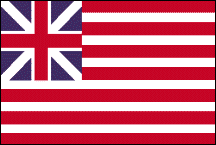 Grand Union (Continental
Colors): This flag was never officially
sanctioned by the Continental Congress but was in use from late
1775 until mid 1777. This flag was an alteration of the British
Ensigns or Meteor flag. In its blue canton was the red cross of
St. George and the white cross of St. Andrew. The thirteen
stripes signified the original colonies. The white stripes were
actually sewn on many of the British Ensigns. Retaining the
British Union in the canton indicated a continued loyalty, as the
Americans saw it, to the constitutional government against which
they fought. On 1 January 1776, this flag was first raised on
Prospect Hill, which was then called Mount. Pisgah, in
Somerville, MA. At this time the Continental army came into
formal existence. This flag was known as the continental colors
because it represented the entire nation. In one of Washington's
letters he referred to it as the Great Union Flag and it is most
commonly called the Grand Union today.
Grand Union (Continental
Colors): This flag was never officially
sanctioned by the Continental Congress but was in use from late
1775 until mid 1777. This flag was an alteration of the British
Ensigns or Meteor flag. In its blue canton was the red cross of
St. George and the white cross of St. Andrew. The thirteen
stripes signified the original colonies. The white stripes were
actually sewn on many of the British Ensigns. Retaining the
British Union in the canton indicated a continued loyalty, as the
Americans saw it, to the constitutional government against which
they fought. On 1 January 1776, this flag was first raised on
Prospect Hill, which was then called Mount. Pisgah, in
Somerville, MA. At this time the Continental army came into
formal existence. This flag was known as the continental colors
because it represented the entire nation. In one of Washington's
letters he referred to it as the Great Union Flag and it is most
commonly called the Grand Union today.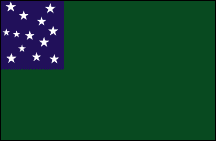 Green Mountain Boys: On 16
August 1777 the Green Mountain Boys fought under General Stark at
the Battle of Bennington. This flag's green field represented
their name and the thirteen white stars a tribute to the thirteen
colonies. A notable victory of the Green Mountain Boys under
Ethan Allen occurred on the morning of 10 May 1775, when they
silently invaded the British held Fort Ticonderoga and demanded
its surrender "In the name of the great Jehovah and the
Continental Congress". The captured cannon and mortars were
transported across the snow covered mountains of New England.
This surprise installation on the heights over Boston Harbor
enabled George Washington to force the British to leave that
important harbor.
Green Mountain Boys: On 16
August 1777 the Green Mountain Boys fought under General Stark at
the Battle of Bennington. This flag's green field represented
their name and the thirteen white stars a tribute to the thirteen
colonies. A notable victory of the Green Mountain Boys under
Ethan Allen occurred on the morning of 10 May 1775, when they
silently invaded the British held Fort Ticonderoga and demanded
its surrender "In the name of the great Jehovah and the
Continental Congress". The captured cannon and mortars were
transported across the snow covered mountains of New England.
This surprise installation on the heights over Boston Harbor
enabled George Washington to force the British to leave that
important harbor.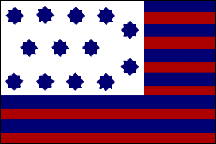 Guilford Courthouse: This flag
was raised over the Guilford Courthouse in North Carolina on 15
March 1781. Under the leadership of General Greene, militiamen
halted the British advance through the Carolinas and turned them
back to the seaport towns. This was one of the bloodiest battles
of the Revolutionary War with the British losing over 25% of
their troops.
Guilford Courthouse: This flag
was raised over the Guilford Courthouse in North Carolina on 15
March 1781. Under the leadership of General Greene, militiamen
halted the British advance through the Carolinas and turned them
back to the seaport towns. This was one of the bloodiest battles
of the Revolutionary War with the British losing over 25% of
their troops.

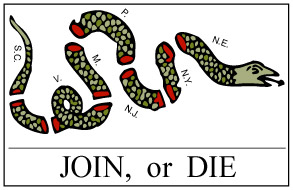 Join or Die:
This
started off as a political cartoon statement printed in
newspapers and handbills. It quickly spread in popularity among
some colonists and was adapted to use in some variations of the
flags used to defy the British and to unify the colonists.
Join or Die:
This
started off as a political cartoon statement printed in
newspapers and handbills. It quickly spread in popularity among
some colonists and was adapted to use in some variations of the
flags used to defy the British and to unify the colonists.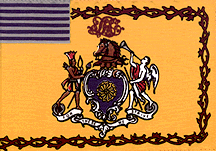 Philadelphia Light Horse Troop:
This troop was formed by a group of Philadelphia gentlemen on 17
November 1774. Many were businessmen and merchants who supplied
their own uniforms, military equipment and horses. The flag was
contributed to the unit by Captain Markoe. It was designed by
John Folwell and painted by James Claypoole. The British Union
was originally painted in the canton but the artist was
instructed to paint thirteen stripes instead, to represent the
united colonies. It was this troop of men that escorted General
Washington from Philadelphia to take command of the Continental
Army which was assembled at Cambridge outside of Boston in June,
1775. The Light Horse Troop later carried their flag in the
Battles of Brandywine, Germantown, Princeton and Trenton.
Philadelphia Light Horse Troop:
This troop was formed by a group of Philadelphia gentlemen on 17
November 1774. Many were businessmen and merchants who supplied
their own uniforms, military equipment and horses. The flag was
contributed to the unit by Captain Markoe. It was designed by
John Folwell and painted by James Claypoole. The British Union
was originally painted in the canton but the artist was
instructed to paint thirteen stripes instead, to represent the
united colonies. It was this troop of men that escorted General
Washington from Philadelphia to take command of the Continental
Army which was assembled at Cambridge outside of Boston in June,
1775. The Light Horse Troop later carried their flag in the
Battles of Brandywine, Germantown, Princeton and Trenton.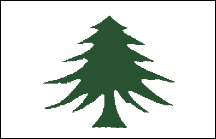 Pine Tree: The
Pine Tree flag is a generic name for a number of flags used by
Massachusetts and by New England colonies from 1686 to 1778. It
was officially adopted by the Massachusetts Navy in April 1776.
It flew over the floating batteries which sailed down the Charles
River to attack the then British held Boston. On 20 October 1775,
Colonel Joseph Reed, Washington's military secretary, recommended
that this flag be put into general usage so that American ships
could recognize one another.
Pine Tree: The
Pine Tree flag is a generic name for a number of flags used by
Massachusetts and by New England colonies from 1686 to 1778. It
was officially adopted by the Massachusetts Navy in April 1776.
It flew over the floating batteries which sailed down the Charles
River to attack the then British held Boston. On 20 October 1775,
Colonel Joseph Reed, Washington's military secretary, recommended
that this flag be put into general usage so that American ships
could recognize one another.
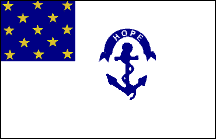 Rhode Island Regiment: In Rhode
Island the anchor has been used as a government symbol since 1647
and is carried in the current state flag. The anchor represents
Rhode Island's seafaring activities and the thirteen stars, the
original thirteen colonies. The native Rhode Islanders were among
the first to join the Minutemen outside Boston. The Rhode Island
Regiments served at the Battles of Brandywine, Trenton and
Yorktown. This flag is preserved today in the State House at
Providence, Rhode Island
Rhode Island Regiment: In Rhode
Island the anchor has been used as a government symbol since 1647
and is carried in the current state flag. The anchor represents
Rhode Island's seafaring activities and the thirteen stars, the
original thirteen colonies. The native Rhode Islanders were among
the first to join the Minutemen outside Boston. The Rhode Island
Regiments served at the Battles of Brandywine, Trenton and
Yorktown. This flag is preserved today in the State House at
Providence, Rhode Island
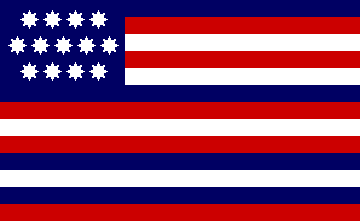 Serapis This flag is named for
the British ship H.M.S. Serapis that John Paul Jones captured in
one of the most famous sea battles of the Revolutionary War. In
winning the battle, Jones's own ship the Bon-Homme Richard was so
damaged that he was forced to abandon his sinking ship and
transfer to the Serapis. It was this flag that flew above the
Serapis when it sailed into the Dutch Port of Texel.
Serapis This flag is named for
the British ship H.M.S. Serapis that John Paul Jones captured in
one of the most famous sea battles of the Revolutionary War. In
winning the battle, Jones's own ship the Bon-Homme Richard was so
damaged that he was forced to abandon his sinking ship and
transfer to the Serapis. It was this flag that flew above the
Serapis when it sailed into the Dutch Port of Texel.
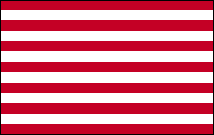 Sons
of Liberty : This was the flag of the early
colonist who had joined together in the protest against the
British impositions on American economic freedom. One such
protest was resistance to the Stamp Act 7 October 1765. A
delegate from each of the nine colonies formed the Stamp Act
Congress . They petitioned the king and parliament to rescind the
Stamp Act. The flag of nine red and white stripes that
represented the Sons of Liberty became known as the
"Rebellious Stripes." On 16 December 1773, the Sons of
Liberty protested the parliament's Tea Act, by
"hosting" Boston Tea Party. The colonists' believed the
tax to be a violation of their legitimate economic liberty. Three
and a half years after the Tea Party the thirteen colonies had
come together in their decision to fight for independence and the
nine stripes had grown to thirteen.
Sons
of Liberty : This was the flag of the early
colonist who had joined together in the protest against the
British impositions on American economic freedom. One such
protest was resistance to the Stamp Act 7 October 1765. A
delegate from each of the nine colonies formed the Stamp Act
Congress . They petitioned the king and parliament to rescind the
Stamp Act. The flag of nine red and white stripes that
represented the Sons of Liberty became known as the
"Rebellious Stripes." On 16 December 1773, the Sons of
Liberty protested the parliament's Tea Act, by
"hosting" Boston Tea Party. The colonists' believed the
tax to be a violation of their legitimate economic liberty. Three
and a half years after the Tea Party the thirteen colonies had
come together in their decision to fight for independence and the
nine stripes had grown to thirteen. Tauton: This is another example
of the colonists' modifying a British flag such as the British
Red Ensign. This flag was raised on the Liberty pole in Taunton,
MA on 21 October 1774. Sometimes only the word
"LIBERTY" was added to the flag.
Tauton: This is another example
of the colonists' modifying a British flag such as the British
Red Ensign. This flag was raised on the Liberty pole in Taunton,
MA on 21 October 1774. Sometimes only the word
"LIBERTY" was added to the flag.
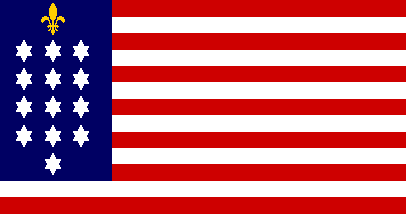 United
States-French Alliance: In 1781-1782, in honor of the end of the Revolutionary War
and in recognition for the assistance of France in that conflict, a special
United
States-French Alliance: In 1781-1782, in honor of the end of the Revolutionary War
and in recognition for the assistance of France in that conflict, a special
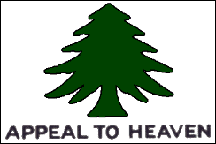 Washington Cruisers: This flag
was another variation of the New England Pine Tree flag. The Sons
of Liberty would rally under a large tree in Boston which came to
be known as "The Liberty Tree". This tree became a
symbol of American independence. This flag was used by George
Washington on his squadron of six schooners which he outfitted at
his own expense in the fall of 1775. Knowing they were up against
a great military power, they believed they were sustained by
still a greater power, thus their "Appeal to Heaven"
Washington Cruisers: This flag
was another variation of the New England Pine Tree flag. The Sons
of Liberty would rally under a large tree in Boston which came to
be known as "The Liberty Tree". This tree became a
symbol of American independence. This flag was used by George
Washington on his squadron of six schooners which he outfitted at
his own expense in the fall of 1775. Knowing they were up against
a great military power, they believed they were sustained by
still a greater power, thus their "Appeal to Heaven"
 Washington's Headquarters
Flag: This flag was used by General George
Washington to designate his headquarters.
Washington's Headquarters
Flag: This flag was used by General George
Washington to designate his headquarters.
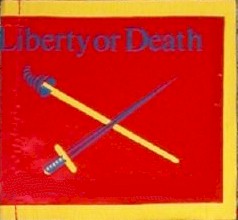 White
Plains Flag: This flag was carried by some American fighters on
28 October 1776 at the battle of White Plains, NY where George Washington's Army
opposed British General William Howe in what was considered the 4th and final
battle for New York.
White
Plains Flag: This flag was carried by some American fighters on
28 October 1776 at the battle of White Plains, NY where George Washington's Army
opposed British General William Howe in what was considered the 4th and final
battle for New York.